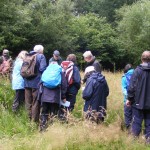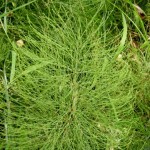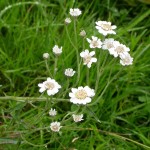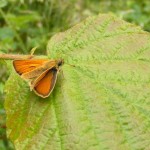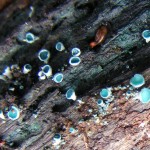The walk at Pamber Forest on Wednesday 18th July, led by Jan Haseler, had been planned to coincide with the peak flight period for the woodland butterflies, the White Admirals, Silver-washed Fritillaries and Purple Emperors, but the sky was overcast and there had been an exceptional amount of rain in the preceding weeks, so it was mud rather than butterflies which typified the morning. The walk started from the car park at Impstone Road at the north-west corner of the Forest. In the grassy ride beside the first stream, Common Cow-wheat, Tutsan, Betony and Marsh Thistle were all in flower and Ringlets were still flying, despite the cloudy conditions. The observant botanists at the back of the group also spotted Trailing St John’s-wort and Broad-leaved Helleborine. There were many clumps of Hard Fern, with fertile fronds in the centre and infertile fronds on the outside. The route then turned southwards into the main spine ride which crosses the forest. The berries were beginning to form on a big Alder Buckthorn. Pamber Forest is one of the North Hampshire strongholds for the uncommon Wood Horsetail which was growing at the side of the track.
The path then looped through a heathy section, where abundant bilberries were enjoyed by some of the group. A Tawny Grisette fungus still had a substantial part of the veil remaining and its tawny cap had a serrated edge. Betony, Lesser Spearwort and Lady Fern were found along the next ride. Sneezewort was growing in the open clearing at the end, and in a brief brighter moment, a pair of Small Skipper butterflies was seen. Continuing southwards along the main track, Common Spotted-orchids and False Fox Sedge were amongst the plants in the verge. The fungus Mycena pelianthina had a smell of radishes and purple-edged gills and a piece of blue-green stained wood had fruiting bodies of the Green Wood-cup. A Silver-washed Fritillary was disturbed from bramble blossom, but flew off before the people at the back had a chance to see it. Next destination was the pond, which would have been good for dragonflies on a sunny day, but alas none were to be seen. A lizard was spotted hiding in a twiggy bush at the side of the pond and it remained there motionless while most people had a look at it. The next fenced section was wood pasture with a distinctive browse line on all the trees. An area of open acid grassland had Common Centaury, Bird’s-foot Trefoil and many Cinnabar caterpillars on Ragwort. A Wild Service-tree was spotted on the final climb back to the cars. The walk was followed by lunch at the Plough at Little London.
Pictures by Rob Stallard and Jan Haseler

